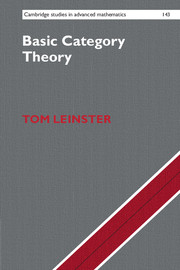Book contents
1 - Categories, functors and natural transformations
Published online by Cambridge University Press: 05 August 2014
Summary
A category is a system of related objects. The objects do not live in isolation: there is some notion of map between objects, binding them together.
Typical examples of what ‘object’ might mean are ‘group’ and ‘topological space’, and typical examples of what ‘map’ might mean are ‘homomorphism’ and ‘continuous map’, respectively. We will see many examples, and we will also learn that some categories have a very different flavour from the two just mentioned. In fact, the ‘maps’ of category theory need not be anything like maps in the sense that you are most likely to be familiar with.
Categories are themselves mathematical objects, and with that in mind, it is unsurprising that there is a good notion of ‘map between categories’. Such maps are called functors. More surprising, perhaps, is the existence of a third level: we can talk about maps between functors, which are called natural transformations. These, then, are maps between maps between categories.
In fact, it was the desire to formalize the notion of natural transformation that led to the birth of category theory. By the early 1940s, researchers in algebraic topology had started to use the phrase ‘natural transformation’, but only in an informal way. Two mathematicians, Samuel Eilenberg and Saunders Mac Lane, saw that a precise definition was needed. But before they could define natural transformation, they had to define functor; and before they could define functor, they had to define category. And so the subject was born.
- Type
- Chapter
- Information
- Basic Category Theory , pp. 9 - 40Publisher: Cambridge University PressPrint publication year: 2014
- 1
- Cited by



